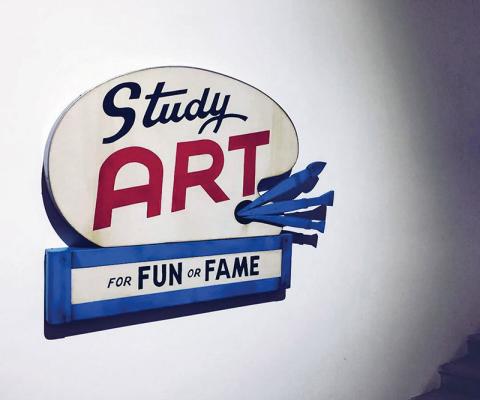The Theory of (Curating) Art
Course cluster considers practice, politics behind curating contemporary art.
What intentions and ideologies are negotiated in the conservation of contemporary art and the curatorial organization of its exhibition?
It’s just one question Tessa Haas ’18 and Olivia Porte ’18 discussed this fall in the 360° course cluster Biennials and Conservation. For these seniors, both history of art majors and museum studies minors, the course is key to developing their views on the purpose and ethical responsibilities of curatorial work as they set their sights on museum careers.
The question of ideology and intention is a critical one for both—they are passionate about the curatorial practice as a means to bring more underrepresented voices into the public spaces of contemporary art. Says Haas, “I’m especially interested in how curating can create a more-inclusive canon of art.”
Porte’s politicized view of art history and art’s display is gaining a vocabulary in Carrie Robbins’ class Contemporary Art in Exhibition: Museums and Beyond, which historicizes the various theories and practices of exhibiting contemporary art, from the Modernist white cube gallery to site-specificity and from public art to relational aesthetics. Porte connects all of this to artist Kara Walker’s installation A Subtlety…, which used a temporary, site-specific work to explore power, race, gender, sexuality, slavery, and the sugar industry.
Says Porte: “Everything we do in life is a political act. I believe art gives one the opportunity to self-actualize and negotiate one’s political presence in our community.”
The second class in the 360° cluster—Marianne Weldon’s Care and Conservation of Contemporary Art—covers the technical aspects of protecting objects and offers a hands-on component. “It’s exciting to go to conservation labs in places like the Pennsylvania Academy of the Fine Arts and the Hirshhorn Museum,” says Haas. “We get to see what it’s like to work in the field. Undergraduates don’t always have access to this type of experiential learning.”
Porte values how the two classes build on each other. “In Marianne’s conservation class, we’re discussing the legal obligations museums have to preserve objects,” says Porte. “Then in Carrie’s class, we’re asking theoretical questions about why art needs
to be preserved at all.”
A highlight of Biennials and Conservation was a trip to the Venice Biennale, one of the world’s most prestigious art events. Both students loved attending this global exhibit, and for Porte, the Venice trip sparked bigger questions. She says, “I started to think about the market-driven aspects of large international exhibitions. What pressures do artists and curators experience to stay on-trend for the Western stage? How are biennials a performance of wealth?”
With graduation nearing, Haas and Porte are planning to work at a museum for a year while applying to graduate programs. Thinking beyond grad school, Haas sees Robbins as a professional inspiration: “She teaches, works on exhibits, and publishes. She has a dream job, and I would love to be in a similar role someday.”
Published on: 12/20/2017
